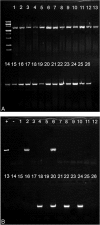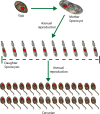Transmission rates of the bacterial endosymbiont, Neorickettsia risticii, during the asexual reproduction phase of its digenean host, Plagiorchis elegans, within naturally infected lymnaeid snails
- PMID: 24383453
- PMCID: PMC3924192
- DOI: 10.1186/1756-3305-6-303
Transmission rates of the bacterial endosymbiont, Neorickettsia risticii, during the asexual reproduction phase of its digenean host, Plagiorchis elegans, within naturally infected lymnaeid snails
Abstract
Background: Neorickettsia are obligate intracellular bacterial endosymbionts of digenean parasites present in all lifestages of digeneans. Quantitative information on the transmission of neorickettsial endosymbionts throughout the complex life cycles of digeneans is lacking. This study quantified the transmission of Neorickettsia during the asexual reproductive phase of a digenean parasite, Plagiorchis elegans, developing within naturally parasitized lymnaeid pond snails.
Methods: Lymnaea stagnalis snails were collected from 3 ponds in Nelson County, North Dakota and screened for the presence of digenean cercariae. Cercariae were identified to species by PCR and sequencing of the 28S rRNA gene. Neorickettsia infections were initially detected using nested PCR and sequencing of a partial 16S rRNA gene of pooled cercariae shed from each parasitized snail. Fifty to 100 single cercariae or sporocysts were isolated from each of six parasitized snails and tested for the presence of Neorickettsia using nested PCR to estimate the efficiency at which Neorickettsia were transmitted to cercariae during asexual development of the digenean.
Results: A total of 616 L. stagnalis were collected and 240 (39%) shed digenean cercariae. Of these, 18 (8%) were Neorickettsia-positive. Six Neorickettsia infections were selected to determine the transmission efficiency of Neorickettsia from mother to daughter sporocyst and from daughter sporocyst to cercaria. The prevalence of neorickettsiae in cercariae varied from 11 to 91%. The prevalence of neorickettsiae in sporocysts from one snail was 100%.
Conclusion: Prevalence of Neorickettsia infection in cercariae of Plagiorchis elegans was variable and never reached 100%. Reasons for this are speculative, however, the low prevalence of Neorickettsia observed in some of our samples (11 to 52%) differs from the high prevalence of other, related bacterial endosymbionts, e.g. Wolbachia in Wolbachia-dependent filariid nematodes, where the prevalence among progeny is universally 100%. This suggests that, unlike the Wolbachia-filaria relationship, the Neorickettsia-digenean relationship is not obligatory mutualism. Our study represents the first quantitative estimate of the Neorickettsia transmission through the asexual phase of the digenean life cycle.
Figures



Similar articles
-
The numbers game: quantitative analysis of Neorickettsia sp. propagation through complex life cycle of its digenean host using real-time qPCR.Parasitol Res. 2016 Jul;115(7):2779-88. doi: 10.1007/s00436-016-5027-0. Epub 2016 Apr 4. Parasitol Res. 2016. PMID: 27041341
-
Laboratory maintenance of the bacterial endosymbiont, Neorickettsia sp., through the life cycle of a digenean, Plagiorchis elegans.Exp Parasitol. 2015 Oct;157:78-83. doi: 10.1016/j.exppara.2015.06.015. Epub 2015 Jul 6. Exp Parasitol. 2015. PMID: 26160679 Free PMC article.
-
Germs within Worms: Localization of Neorickettsia sp. within Life Cycle Stages of the Digenean Plagiorchis elegans.Appl Environ Microbiol. 2016 Apr 4;82(8):2356-2362. doi: 10.1128/AEM.04098-15. Print 2016 Apr. Appl Environ Microbiol. 2016. PMID: 26873314 Free PMC article.
-
Neorickettsial endosymbionts of the digenea: diversity, transmission and distribution.Adv Parasitol. 2012;79:253-97. doi: 10.1016/B978-0-12-398457-9.00003-2. Adv Parasitol. 2012. PMID: 22726644 Review.
-
Digenean-gastropod host associations inform on aspects of specific immunity in snails.Dev Comp Immunol. 2015 Feb;48(2):275-83. doi: 10.1016/j.dci.2014.06.014. Epub 2014 Jul 14. Dev Comp Immunol. 2015. PMID: 25034871 Free PMC article. Review.
Cited by
-
An Ecotype of Neorickettsia risticii Causing Potomac Horse Fever in Canada.Appl Environ Microbiol. 2016 Sep 16;82(19):6030-6. doi: 10.1128/AEM.01366-16. Print 2016 Oct 1. Appl Environ Microbiol. 2016. PMID: 27474720 Free PMC article.
-
The numbers game: quantitative analysis of Neorickettsia sp. propagation through complex life cycle of its digenean host using real-time qPCR.Parasitol Res. 2016 Jul;115(7):2779-88. doi: 10.1007/s00436-016-5027-0. Epub 2016 Apr 4. Parasitol Res. 2016. PMID: 27041341
-
Diversity of Ehrlichia spp., Anaplasma spp. and Neorickettsia spp. in vampire bats.Curr Res Parasitol Vector Borne Dis. 2024 May 31;5:100182. doi: 10.1016/j.crpvbd.2024.100182. eCollection 2024. Curr Res Parasitol Vector Borne Dis. 2024. PMID: 38952690 Free PMC article.
-
Laboratory maintenance of the bacterial endosymbiont, Neorickettsia sp., through the life cycle of a digenean, Plagiorchis elegans.Exp Parasitol. 2015 Oct;157:78-83. doi: 10.1016/j.exppara.2015.06.015. Epub 2015 Jul 6. Exp Parasitol. 2015. PMID: 26160679 Free PMC article.
-
Opisthorchis viverrini, Clonorchis sinensis and Opisthorchis felineus liver flukes affect mammalian host microbiome in a species-specific manner.PLoS Negl Trop Dis. 2023 Feb 13;17(2):e0011111. doi: 10.1371/journal.pntd.0011111. eCollection 2023 Feb. PLoS Negl Trop Dis. 2023. PMID: 36780567 Free PMC article.
References
-
- Madigan JE, Pusterla N. Ehrlichial diseases. Vet Clin North Am Equine Pract. 2000;6:487–499. - PubMed
Publication types
MeSH terms
Grants and funding
LinkOut - more resources
Full Text Sources
Other Literature Sources
Molecular Biology Databases
Research Materials

